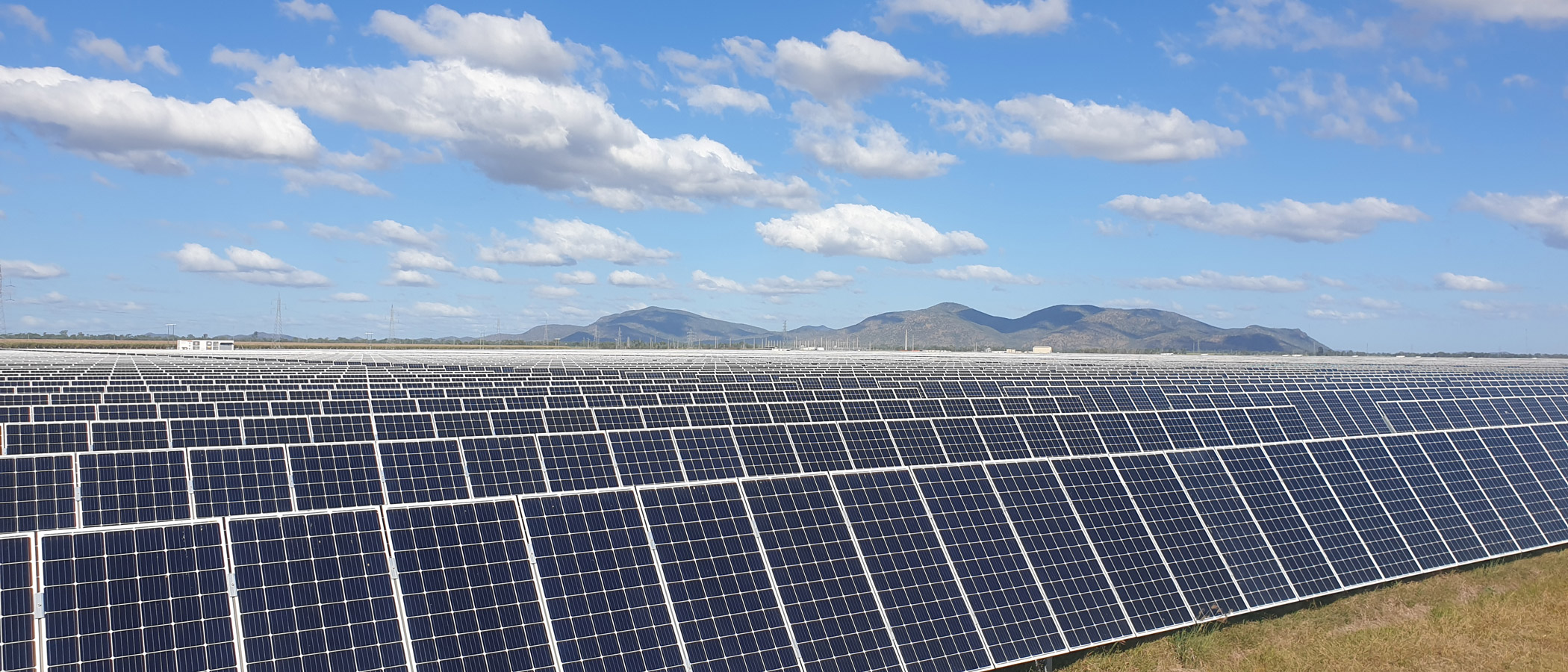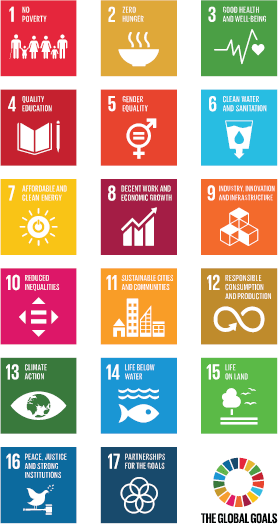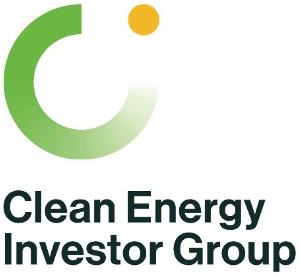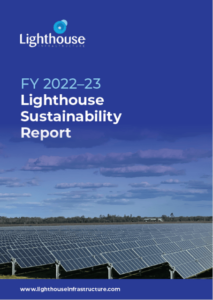
Our sustainable investment philosophy
Lighthouse believes that returns for investors in real assets will be maximised over the long term on the basis that environmental, social and economic utility is sustained and underpinned by a robust and appropriate governance regime.
Our approach to sustainability and our commitment to responsible investment
Sustainability is the ability to maintain a given level of activity. Lighthouse relates this capacity to its investment and asset management activities by strongly believing in:

Environmental sensitivity
Humanity is challenged by resource depletion and climate change. To ensure our investments are sustainable, they must efficiently utilise scarce resources while minimising environmental impact.

Social responsibility
Infrastructure assets provide essential services to communities they serve and inform and contribute to the public good. For their activities to be sustainable, investors and asset managers must provide access to essential services in a fair and an efficient manner.

Economic productivity
For any activity to be sustainable it must be productive. Investment activity must provide mutual benefits to users and to owners.
Environmental, social and economic utility drive investment returns which are achieved through the alignment of these factors. We ethically manage and are responsible stewards of our assets for the long-term performance of our clients. Sustainable value can be created over longer term periods through the active management of opportunities and the control and mitigation of risks over the life cycle of the assets.
Our commitment to addressing climate change
It is now more pressing than ever that the urgent challenges of climate change and the decarbonisation of the economy are addressed.
Commencing in 2021, Lighthouse has measured the greenhouse gas (GHG) emissions of its corporate and investment portfolio in line with the Partnership for Carbon Accounting Financials (PCAF) framework and will continue to report on our climate impact going forward. We have most recently identified our scope 1, 2 and 3 emissions for the financial year 2024.
Lighthouse has committed to and achieved ‘carbon neutrality’ at a corporate level. We are pleased to report that Lighthouse Infrastructure’s business operations have been officially certified as carbon neutral for FY2022, FY2023 and FY2024.
In recognising the complex nature of implementing a net-zero carbon strategy at a portfolio level, we will continue to explore the pathway to net-zero, defined as reducing scope 1, 2, and 3 emissions to zero or to a residual level aligned with the Intergovernmental Panel on Climate Change (IPCC) 1.5˚C scenario and neutralising any residual emissions using carbon credits or other carbon removal measures.


The Paris Agreement
The Paris Agreement is a legally binding international treaty on climate change. It was adopted by 196 parties in Paris, on 12 December 2015 and entered into force on 4 November 2016. Its overarching goal is to hold “the increase in global average temperature increase to 1.5ºC above pre-industrial levels”.
To limit global warming to 1.5ºC, greenhouse gas emissions must peak before 2025 at the latest and decline 43% by 2030.
The Paris Agreement is a landmark in the multilateral climate change process because, for the first time, a binding agreement brings all nations into a common cause to undertake ambitious efforts to combat climate change and adapt to its effects.
Source: UN Climate Change, The Paris Agreement
Our sustainable development goals integration journey
The United Nations (UN) Sustainable Development Goals (SDGs) are a collection of 17 interlinked global goals designed to be a “blueprint to achieve a better and more sustainable future for all”.
The UN Sustainable Development Goals (SDGs) were set in 2015 by the United Nations General Assembly and are intended to be achieved by the year 2030. Whilst many of the specific targets underlying the goals relate to improving conditions in developing countries, a significant number of the targets and indicators have application within developed nations.
Since 2021, Lighthouse has increasingly considered the UN SDGs to be an important and effective framework to help guide our investment selection process. There is a significant link that exists between many of the UN SDGs, our sustainable investment philosophy and the social and environmental outcomes generated by the operation and usage of Lighthouse’s infrastructure assets.
In late 2021, Lighthouse team members completed a United Nations Institute for Training and Research (UNITAR) training course on SDG implementation. In 2021 the Lighthouse Team reviewed and revised its purpose statement and its corporate values, which are key components of the Lighthouse Infrastructure Value Chain. Our Value Chain illustrates the inputs into our business, the transformation and value creation processes we undertake, the outputs and outcomes we ultimately deliver and those we aspire to achieve.

SDG selection and integration
As an organisation we have mapped the SDGs into our investment value chain by considering how our core competencies, technologies and investment funds currently and potentially can contribute to the SDGs.
As part of this mapping exercise, we have established five key areas where we consider our capabilities and actual and potential outputs to be well-placed to create value for multiple stakeholders being our investors, employees, partners, those who use the services created by our infrastructure assets and those who are affected by their operation.
The five key areas we have identified are:
1. Better economic outcomes
For any activity to be sustainable it must be productive. Investment activity must provide mutual benefits to users and to owners. Careful asset selection with aligned ESG principles, embedding further ESG integration and reporting, can produce a lower cost of capital for assets we invest in, creating additional value for our investors.
2. Partnerships for success
Development and fostering of meaningful relationships with investors, partners, advisors, policy makers and employees will be essential to delivering truly sustainable outcomes through the provision of essential services on real assets.
3. Technology and innovation
We value innovation, encouraging and supporting our team members to complete research, think creatively and devise new investment and support solutions which generate financial value for our investors. We aim to use technology to optimise the performance of existing and new assets to increase gains of financial returns, asset efficiency, safety, security and sustainability performance.
4. Improved environmental outcomes
Humanity is challenged by resource depletion and climate change. To ensure our investments are sustainable, they must efficiently utilise scarce resources while minimising environmental impact.
5. Improved social outcomes
Infrastructure assets provide essential services to communities they serve and inform and contribute to the public good. For their activities to be sustainable, investors and asset managers must provide access to essential services in a fair and an efficient manner. We look to support our service providers, other key relationships, and the communities where we invest.
For each of these five outcomes we have identified specific areas of focus and objectives that allows us to measure and report progress going forward. This helps us gain a deeper understanding of the targets and indicators of each relevant SDG to enhance our reporting of improvement against these SDGs.
Are you interested in reviewing further details of Lighthouse’s sustainability activities and initiatives in practice? If so, you can access a copy of the FY 2022-23 Lighthouse Sustainability Report here.
Memberships and supported initiatives
Lighthouse is committed to sustainable investment and supports the following initiatives:

United Nations Principles for Responsible Investment (UNPRI)
Lighthouse is a signatory to the UNPRI. The six Principles for Responsible Investment are a voluntary and an aspirational set of investment principles that offer a range of possible actions for incorporating ESG issues into investment practices. In implementing them, signatories contribute to developing a more sustainable global financial system.

Investor Group for Climate Change (IGCC)
Lighthouse is a member of the IGCC and has been an active contributor to a number of initiatives over the years including participation on a number of working sub-committees.

Clean Energy Investor Group (CEIG)
Lighthouse is a founding member of the CEIG. Across regulation and policy arenas the CEIG initiates, investigates, and responds to consultations and national electricity rule changes that impact institutional investors’ interests in the renewable energy sector.

Pension Governance and Innovation Forum & “Infrastructure Matters” initiative – Harvard Alumni Entrepreneurs
In 2019, Lighthouse created the Infrastructure Matters initiative as part of the Harvard Alumni Entrepreneurs, a cross-faculty group of the University Alumni. The purpose of the initiative is to advance work on pensions and capital stewardship, on the nature of infrastructure, on the relevance of infrastructure-related enterprises as objects of investment by pension funds and other investors, including Islamic investors, on the roles and responsibilities of government and the private sector in this connection, and on the impact on and import of any such investments on the lives and livelihoods of those affected.
The Harvard Alumni Entrepreneurs Pension Governance and Innovation Forum was formed in 2021 to apprise, to focus, to educate workers, scholars, policymakers, researchers, and pension fund, infrastructure investment, and other practitioners on issues such as fiduciary duty and pension fund governance, management, and investment, especially as they bear upon plan members gaining financial security in retirement.
Lighthouse has remained active in each of the Infrastructure Matters initiative and the Innovation Forum during the Period.
You can access a copy of the Lighthouse Infrastructure Environmental, Social and Governance (ESG) policy here.
Case Study
Lighthouse Secures Australia’s First Social Loan for Specialist Disability Accommodation
In October 2023, Lighthouse Infrastructure (Lighthouse) secured Australia’s first social loan dedicated to funding Specialist Disability Accommodation (SDA). The value of the social loan exceeded AUD $130 million and was issued in equal part by Commonwealth Bank of Australia (CBA) and National Australia Bank (NAB).
The loan enables the expansion of SDA assets within Lighthouse’s Australian Disability Accommodation Projects Trust 2 Fund (ADAPT2), an evergreen fund exclusively focused on long-term investments in Australian SDA. Backed by capital provided by investor Victorian Funds Management Corporation (VFMC), the Fund encompasses both the development and construction of new SDA assets and the acquisition of operational SDA properties that align with the fund’s investment criteria. Lighthouse is one of the largest institutional investors in Australian SDA assets.
Social-labelled loans are a type of sustainable finance that’s used to fund projects and activities that address a social issue or achieve positive social outcomes for certain populations, particularly underserved, marginalised and vulnerable groups. Social finance is a nascent market in Australia, and one that Lighthouse is helping to develop with this innovative transaction that applied the Social label to SDA. At the time this social loan was announced (October 2023), only four social loans had been issued in total in Australia. As awareness of social investments grows amongst institutional investors, other formats for financing SDA including social bonds may follow in the future, making Lighthouse’s debut in the social loan market an important step in the evolution of this asset class
In establishing the social loan, CBA and NAB served as Joint Sustainability Coordinators, collaborating with Lighthouse to develop its Sustainable Financing Framework. This comprehensive framework articulates Lighthouse’s approach to undertaking and managing its social loans, while detailing the eligible social assets, projects and target populations set to benefit from the proceeds. Lighthouse sought to adhere to market best practice by aligning its framework to the Social Loan Principles issued by the Asia Pacific Loan Market Association (APLMA).


